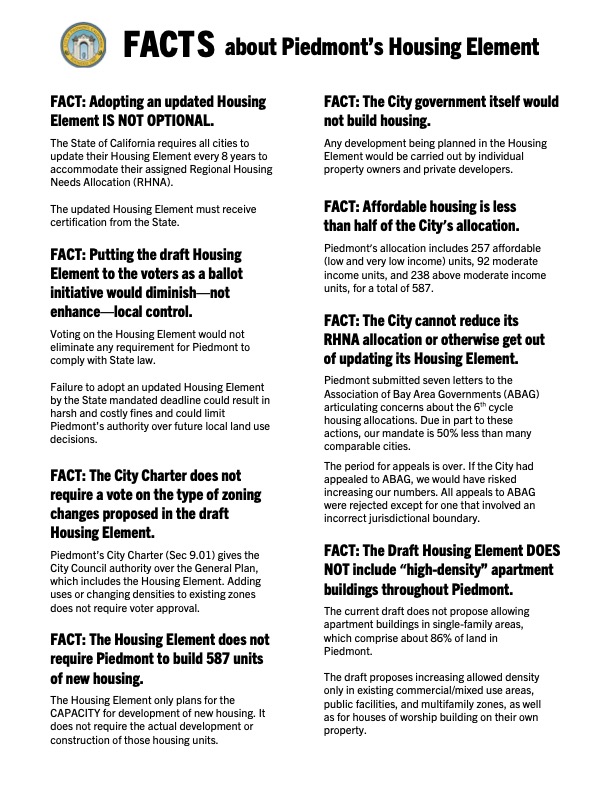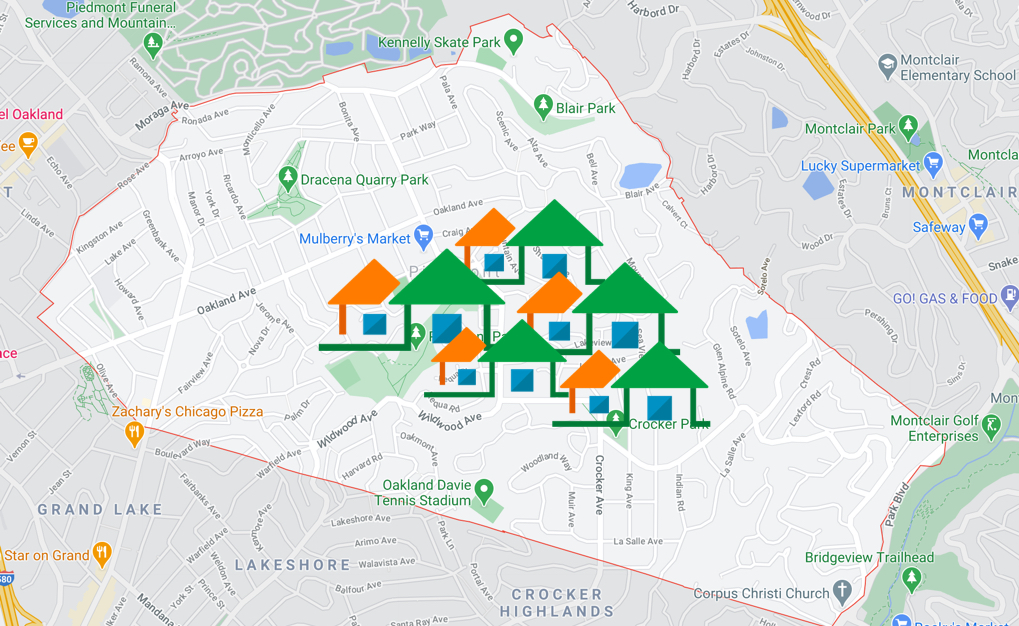How the City of Piedmont should update its Housing Element to accommodate its Regional Housing Needs Allocation (RHNA) of 587 new units has been the topic of much community debate and a focal point for candidates running for open City Council seats this November.
The debate is not unique to Piedmont — all cities in California are being asked to do more to address the housing shortage. The San Francisco Chronicle on Thursday published an article (see: California housing officials tell Oakland to plan for more homes in pricey Rockridge neighborhood) that shows what can happen when cities don’t make an authentic effort to address the problem.
A July article (see: Bay Area cities face long odds in fighting state-mandated housing goals) noted that “Earlier this year, 47 cities and counties in Southern California appealed their allocation numbers. All the appeals were rejected. So far the courts have tossed out lawsuits filed against the state housing agency by jurisdictions objecting to their RHNA number.”
This week the City posted a fact sheet designed to dispel some frequently misunderstood aspects of what that 587 number means and other details of the Housing Element process:

The city’s website, piedmontishome.org, is a clearinghouse for information about new housing policy in Piedmont and Housing Element project updates.

I don’t know the economics of housing development but doesn’t going from 4 to 5 stories make conversion of the Ace site MORE profitable and likely? Look at the foot traffic in that store, many from Piedmont, not to mention the number of jobs. Michael is right – an SB9 analysis and some accounting of growth in the adjacent multi-family zone would probably offset the need to go to 5 stories at the Ace site, something the City is now contemplating.
#3 in the Fact Sheet deserves a lot more explanation.
The third “Fact” on the city list could easily be questioned. It is merely an assertion not a reasoned demonstration of a valid legal position. The Council should ask for a detailed exposition of what the city’s claim is with full legal back up.
Zoning has a long history in American local government. Zoning refers to the division of a city into categories by a map, both by use and standards (heights, setbacks, coverage, traffic, parking, etc). The position that the uses and standards of one district can be added to or replace the standards of another zone without considering it a zone change is doubtful on its face. That would essentially mean zoning districts mean nothing. Before the city position can be challenged, it needs to be explained; in detail and in writing with points and authorities. The citizens concerned about the proposed Housing Element’s impact should expect such a legal analysis from the city.
The current Draft Housing Element, in promoting high density low-income housing along Grand, means the elimination of Ace Hardware. I have yet to hear from City Staff how Ace will remain with the 40+ low income units envisioned on that site plus parking. If there is zoning contemplated that lets Ace remain on the ground floor, there is still the real question of whether Ace Hardware could return after a several year construction hiatus. With its clean store, extensive inventory, fair prices and helpful, experienced staff, Ace Hardware is ingrained in the fabric of Piedmont. More thought should have been undertaken by the Housing Consultant – Lisa Wise Consulting and David Bergman – rather than applying a cookie-cutter approach that did not embrace the value of spreading housing through out town with JADU, ADUs and small home thereby leaving the basic character intact. And let Ace Hardware remain at the bottom of the hill.
Rick Schiller, I absolutely agree that the Ace Hardware is a great treasure for our community. One thing that is important to keep in mind: Including a site on the inventory does not mean that housing will definitely be built there. It just means that it is a potential site. The purpose of the Housing Element is not to identify specific building projects, merely to demonstrate general capacity in terms of number of units per acre. I think the bigger issue with that site is whether the state will accept it at all, given the unlikelihood that the current or future owner would demolish it and rebuild with housing. The City will have to furnish some evidence to justify its inclusion. But the fact is, the City is a bit stuck because of the paucity of vacant and large sites in Piedmont, which is why it has named some ones that are less than ideal. ADUs, JADUs, and small homes are all great. But the state has a very specific formula for how many ADUs it will allow Piedmont to claim (around 140-150) and how many of those can be counted as “low-income.” To count toward the low-income capacity, sites have to be at least a half acre. It’s not a matter of the consultants not being willing to think outside the box. It’s a matter of the state being very rigid about the box.
There are some other options which could/should have been considered. While it is true that HCD guidelines wouldn’t allow sites smaller than half acre to count towards low income, part of RHNA is not low income. Smaller sites already zoned for multiple family exist on Linda Avenue, Grand Avenue and Oakland Avenue can be counted towards the market rate RHNA, but are not.
The failure to use SB9 duplexes and lot splits is inexplicable. Many cities are doing so.
In fact, HCD in March published its Fact Sheet detailing how to use SB9 units toward any jurisdictions’ RHNA. A consultant claimed that he’d heard in a private phone call from an unnamed HCD staff member, that, in spite of their published document to the contrary, HCD wouldn’t count SB9 units. The Council should insist on written confirmation from HCD, not the consultant, that SB9 units do not count towards the RHNA. Otherwise, we can correctly assume that HCD does count SB9 units.
Michael Henn, I believe the City is currently looking at those multifamily areas on Linda, Grand and Oakland, in order to address the shortfall created when the City Council removed all the City-owned, City Center sites from the draft inventory.
The fact remains: the City’s 250+ unit low- and very-low-income allocation will be the hardest for the City (and all other cities) to demonstrate adequate capacity for. Even in the draft, the City had a surplus of above-moderate sites, including about 60 single-family in Zones A and E. Meeting our above-moderate targets is not the challenge.
I’m all for SB9, and I hope that we do see some duplex and lot splits in the coming years in Piedmont. I was glad to see the City Council recommending to explore going beyond and enhancing SB9 to increase its effectiveness in Piedmont. However, these would also be above-moderate or moderate-income units and wouldn’t help us with our low-income targets. While some cities may be claiming SB9 sites, it is not at all clear that HCD will accept them. See Redwood City’s experience: The State rejected their draft Housing Element, and cast a skeptical eye on its SB9 projections. (See https://www.rwcpulse.com/redwood-city-news/redwood-citys-housing-element-rejected-by-state-after-being-first-in-the-county-to-submit-5648820)
Given that Piedmont has no substantial track record of lot splits to draw on, even it completed the requisite analysis, I doubt HCD would accept more than 20 units from SB9. And many of the eligible lots would likely be the 60 that the City is already counting for new single-family houses in Zones A and E (an already dubious assumption because many of those sites are steep or have structures on them). So maybe accounting for SB9 yields 10 more units? I have no objections to the City trying to count some SB9 units if it can pass muster with HCD, but it’s hardly a magic bullet.
Not having visited the link Irene provides, my recollection is that Redwood City simply adopted an SB 9 potential estimate from the Terner Center study, 250 I recall. That may be overly simplistic but the methodology is nothing like that recommended by HCD guidance so not surprising it was rejected. Other cities more like Piedmont are submitting SB 9 projections that HCD may approve. Woodside projects 16.
(https://www.almanacnews.com/news/2022/07/13/woodside-council-sends-draft-housing-element-to-the-state.) As I understand it, Atherton looked at existing lots that could be subdivided under it’s current zoning rules (these must be large lots!) and came up with 96. Whatever HCD ultimately denies or approves, these and other cities adopted ordinances in December 2021 and got on top of SB9 implementation. Maybe Piedmont could catch up and get some plausible SB9 numbers into the HE. Yes not low income but moderate units that reduce the need for their development elsewhere in town, especially at Ace.
Asking to see a “track record” of SB9 lot splits in order to be able to count them towards the RHNA makes little sense. The law was not in effect till January of this year. It’s highly unlikely that there could be any track record.
I suspect that the by-right conversion to duplexes will be more productive in new units than lot splits.
Part of my letter and verbal comments to Council:
Re: June 20 Housing Element Hearing
Dear Mayor King and Council,
At the last PC meeting concerning the Housing Element (“HE”) draft Kathryn Slama of Lisa Wise consulting was asking about the potential of satisfying Piedmont’s RHNA by the potential of SB9. Her response was that the State only allows numbers based on past production. Mr. Jackson repeated this information June 7: “Where SB9 is concerned, the State will only allow a jurisdiction to project future housing development at the current rate of production.” This production answer is contrary to published HCD SB9 guidelines.
Attached is the HCD SB9 March 2022 Fact Sheet and kindly view the bottom of page 6 “HOUSING ELEMENT LAW: To utilize projections (italics added) based on SB9 toward a jurisdiction’s regional housing need allocation (RHNA). . .” HCD then lists four elements needed in a Housing Element to have projections count towards a RHNA reductions: site specific inventory, undeveloped site analysis, identify government restrain and show policies that establish zoning standards early in the process. All are well within the ability of the consultants to include in the draft Housing Element. Explicitly HCD has stated a process for potential housing under SB9 to be used to partially satisfy Piedmont’s RHNA. Other Cities such as affluent Atherton are taking this approach.
We have a contradiction between a HCD March document and June verbal comments by the housing consultant. I would have preferred someone on Council or Staff to at least ask for further explanation and understanding. At that time the City projected implementing SB9 guidelines 3 to 4 years out. By public comment that timeline has been moved up.
I agree about Ace – very special asset for Piedmont. Thought experiment – twenty years from now, if you were living in a new 5-story high rise at one of the corners of Grand, Wildwood, Boulevard and Jean, which of the services currently there would you to want to have? For me, Ace, Shell a close second and Siegel’s in that order. This zone deserves some regional planning that encompasses Oakland and Piedmont housing growth.